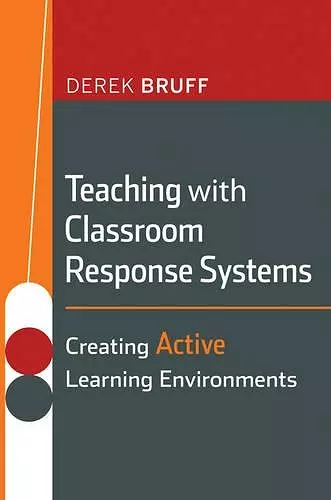Teaching with Classroom Response Systems
Creating Active Learning Environments
Format:Paperback
Publisher:John Wiley & Sons Inc
Published:10th Mar '09
Currently unavailable, and unfortunately no date known when it will be back

There is a need in the higher education arena for a book that responds to the need for using technology in a classroom of tech-savvy students. This book is filled with illustrative examples of questions and teaching activities that use classroom response systems from a variety of disciplines (with a discipline index). The book also incorporates results from research on the effectiveness of the technology for teaching. Written for instructional designers and re-designers as well as faculty across disciplines.
A must-read for anyone interested in interactive teaching and the use of clickers. This book draws on the experiences of countless instructors across a wide range of disciplines to provide both novice and experienced teachers with practical advice on how to make classes more fun and more effective.”--Eric Mazur, Balkanski Professor of Physics and Applied Physics, Harvard University, and author, Peer Instruction: A User’s Manual
“Those who come to this book needing practical advice on using ‘clickers’ in the classroom will be richly rewarded: with case studies, a refreshing historical perspective, and much pedagogical ingenuity. Those who seek a deep, thoughtful examination of strategies for active learning will find that here as well—in abundance. Dr. Bruff achieves a marvelous synthesis of the pragmatic and the philosophical that will be useful far beyond the life span of any single technology.” --Gardner Campbell, Director, Academy for Teaching and Learning, and Associate Professor of Literature, Media, and Learning, Honors College, Baylor University
“Good teachers constantly look for ways to improve instruction. Bruff, Assistant Director of the Vanderbilt University Center for Teaching, surveys how classroom response systems, commonly known as “clicker technology,” can improve teaching and learning.
Bruff supplements his points on engagement and assessment with a classified array of clicker questions for a variety of teaching contexts. He also provides helpful advice on teaching choices with response systems: when to grade clicker questions, how to use them for summative assessment, and how to address cheating and lack of participation. He provides additional helpful suggestions on dealing with logistical issues such as system choice and troubleshooting. Throughout, the reader benefits from the copious examples gleaned from teachers.
This book convincingly demonstrates that clicker technology allows teachers and students to adapt quickly to emerging learning needs….Bruff’s work is an enthusiastic, accessible, and detailed introduction for all educators interested in this popular educational technology tool.”
—NACADA Journal, Issue 30(1) (Spring 2010)
ISBN: 9780470288931
Dimensions: 229mm x 155mm x 18mm
Weight: 304g
240 pages